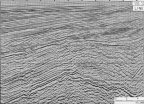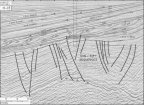Seismic Sequence Analysis
Exercise Two
The
exercise objective is to make a sequence stratigraphic interpretation of a seismic line through
the lower Cretaceous of the offshore of South Africa. The commonest identifiable
geometries are the onlapping strata of transgressions and high stands (commonly
lumped together since they often cannot be separated), and those downlapping
during lowstand regressions.
This is the second of a series of exercises in seismic sequence analysis provided by the SEPM sequence stratigraphy web site. The seismic line used in this exercise is a copy of Figure 39 from page 49 of the AAPG Atlas of the "sequence stratigraphy in offshore South African Divergent basins". The figure was chosen because it contains clear and easy to interpret examples of onlapping and downlapping sequence geometries and a relatively uncomplicated structural fabric.
The figure is from the AAPG Atlas and is one of many other similar
examples that were initially interpreted by Soekor (Pty) Ltd during their
exploration for potential Cretaceous lowstand hydrocarbon traps offshore South
Africa..

To gain access to the graphics image with the un-interpreted seismic section exercise, click on the image above to download it (click here for a smaller version of same section). Print the file of the seismic or transfer it directly to a PC, Notebook, Tablet, or Pad and using drawing tools that include Power Point follow the procedures outlined in the introduction to interpret this. First identify the termination of seismic reflectors at discontinuity surfaces; then establish which of these surfaces form the sequence boundary.
You should follow the procedures outlined in the introduction above to
interpret this line. First identify the termination of seismic reflectors at discontinuity surfaces; then establish which of these surfaces form the sequence boundary. Assume that the framework is result of the generation of repeated successions of accommodation and sediment fill (the accommodation succession of Neal and Abreu, 2009). These accommodation successions vary in magnitude and duration and can be interpreted to be the products of sedimentary packages that accumulated on a depositional profile. successions can be seen to consist of component partial succession sets that sequentially prograde to aggrade, retrograde, and aggrade to prograde to degrade. Follow this by demarking the geometries of the sequences and the systems tracts they include.
Working with a print of the downloaded seismic line:
1) Identify and number the sequence boundaries from the base
up, also identify the major faults.
2) Now indicate the positions of the systems tracts
including "lowstand systems tracts", "transgressive systems
tracts" and "highstand systems tracts". In this seismic data set you will find that the separation
of "transgressive systems tracts" and "highstand systems
tracts" maybe an arbitrary decision so in this case we advise taking the
approach to seismic interpretation followed by Embry and Johannessen (1992) in which
they argue the sections they interpreted could best be separated into T–R
sequence stratigraphic units.
3) Finally construct a chronostratigraphic chart for this seismic section using the methodology described in the section on chronostratigraphy.
 Click on left image to view a the solution and match it with your interpretation(click here for a smaller version of same section).
Click on left image to view a the solution and match it with your interpretation(click here for a smaller version of same section).
References
L.F. Brown, Jr., J. M. Benson, G. J. Brink, S. Doherty, A. Jollands, E. H. A. Jungslager, J. H. G. Keenan, A. Muntingh, and N. J. S. van Wyk, 1996, Sequence stratigraphy in Offshore South African Divergent basins: An Atlas on Exploration for Cretaceous Lowstand Traps by Soekor (Pty) Ltd, AAPG Studies in Geology #41, ISBN#0-89181-049-8, 184 page
Embry, A.F., Johannessen, E.P., 1992, T–R Sequence stratigraphy, facies
analysis and reservoir distribution in the uppermost Triassic- Lower Jurassic
succession, western Sverdrup basin, Arctic Canada. In: Vorren, T.O., Bergsager,
E., Dahl-Stamnes, O.A., Holter, E., Johansen, B., Lie, E., Lund, T.B. (Eds.),
Arctic Geology and Petroleum Potential, vol. 2 (Special Publication). Norwegian
Petroleum Society (NPF), pp. 121–146.
Neal, J., and Abreu, V., 2009, sequence stratigraphy hierarchy and the accommodation succession method, Geology, v. 37, p. 779-782